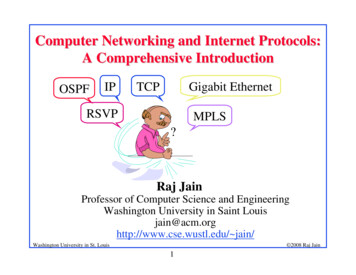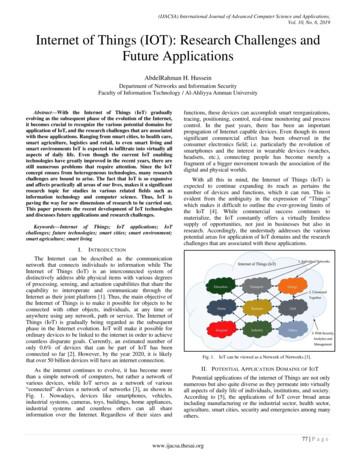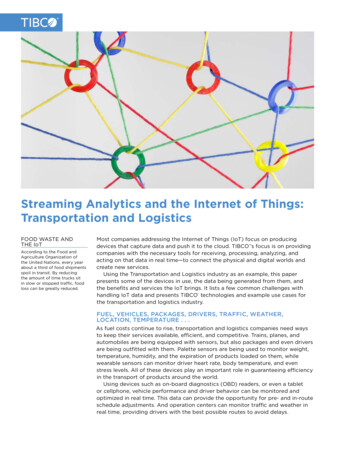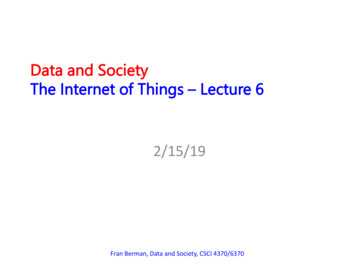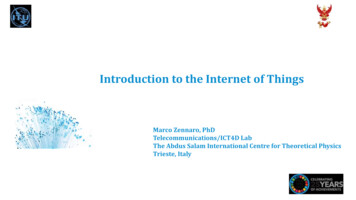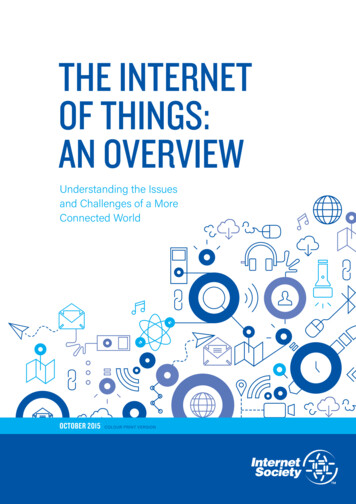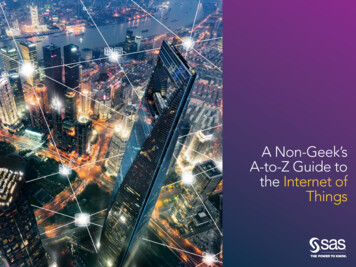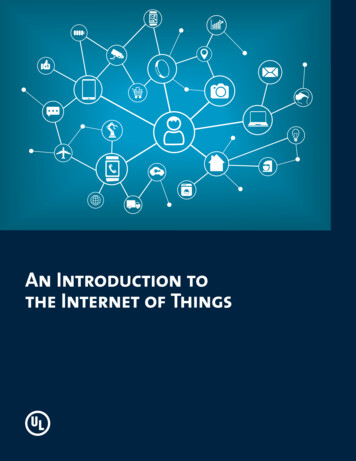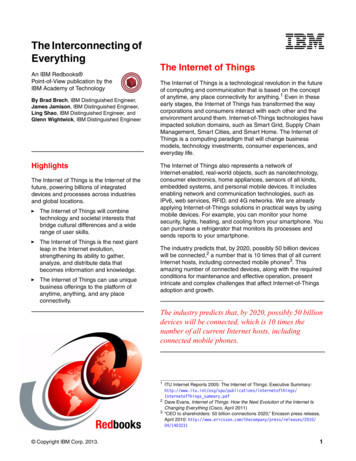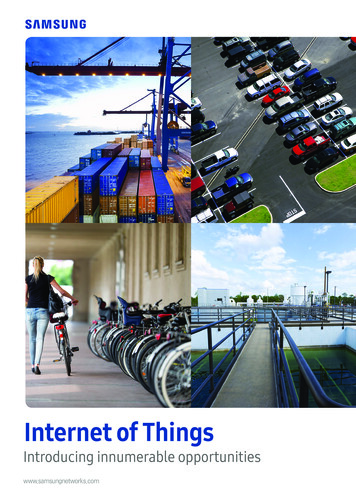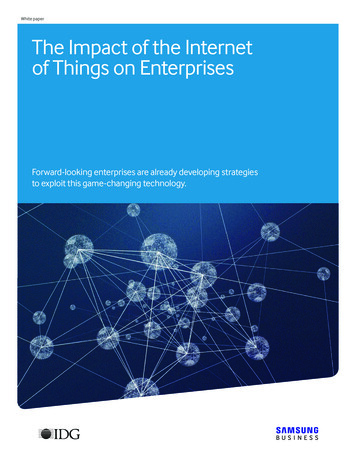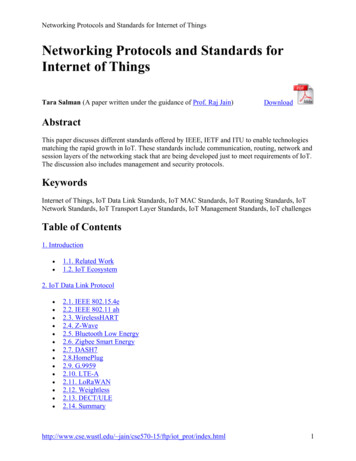
Transcription
Networking Protocols and Standards for Internet of ThingsNetworking Protocols and Standards forInternet of ThingsTara Salman (A paper written under the guidance of Prof. Raj Jain)DownloadAbstractThis paper discusses different standards offered by IEEE, IETF and ITU to enable technologiesmatching the rapid growth in IoT. These standards include communication, routing, network andsession layers of the networking stack that are being developed just to meet requirements of IoT.The discussion also includes management and security protocols.KeywordsInternet of Things, IoT Data Link Standards, IoT MAC Standards, IoT Routing Standards, IoTNetwork Standards, IoT Transport Layer Standards, IoT Management Standards, IoT challengesTable of Contents1. Introduction 1.1. Related Work1.2. IoT Ecosystem2. IoT Data Link Protocol 2.1. IEEE 802.15.4e2.2. IEEE 802.11 ah2.3. WirelessHART2.4. Z-Wave2.5. Bluetooth Low Energy2.6. Zigbee Smart Energy2.7. DASH72.8.HomePlug2.9. G.99592.10. LTE-A2.11. LoRaWAN2.12. Weightless2.13. DECT/ULE2.14. Summaryhttp://www.cse.wustl.edu/ jain/cse570-15/ftp/iot prot/index.html1
Networking Protocols and Standards for Internet of Things3. Network Layer Routing Protocols 3.1. RPL3.2. CORPL3.3. CARP3.4. Summary4. Network Layer Encapsulation Protocols 4.1. 6LoWPAN4.2. 6TiSCH4.3. 6Lo4.4. IPv6 over G.99594.5. IPv6 over Bluetooth Low Energy4.6. Summary5. Session Layer Protocols 5.1. MQTT5.2. SMQTT5.3. AMQP5.4. CoAP5.5. XMPP5.6. DDS5.7. Summary6. IoT Management Protocol 6.1. Interconnection of Heterogeneous Datalink6.2. Smart Transducer Interface7. Security in IoT Protocols 7.1. MAC 802.15.47.2. 6LoWPAN7.3. RPL7.4. Application Layer8. IoT Challenges 8.1. Mobility8.2. Reliability8.3. Scalability8.4. Management8.5. Availability8.6. Interoperabilityhttp://www.cse.wustl.edu/ jain/cse570-15/ftp/iot prot/index.html2
Networking Protocols and Standards for Internet of Things9. Summary List of Acronyms References1. IntroductionInternet of Things (IoT) and its protocols are among the most highly funded topics in bothindustry and academia. The rapid evolution of the mobile internet, mini- hardwaremanufacturing, micro-computing, and machine to machine (M2M) communication has enabledthe IoT technologies. According to Gartner, IoT is currently on the top of their hype-cycle, whichimplies that a large amount of money is being invested on it by the industry. Billions of dollarsare being spent on IoT enabling technologies and research while much more is expected to comein the upcoming years [Gartner14].IoT technologies allow things, or devices that are not computers, to act smartly and makecollaborative decisions that are beneficial to certain applications. They allow things to hear, see,think or act by allowing them to communicate and coordinate with others in order to makedecisions that can be as critical as saving lives or buildings. They transform "things" from beingpassively computing and making individual decisions to actively and ubiquitouslycommunicating and collaborating to make a single critical decision. The underlying technologiesof ubiquitous computing, embedded sensors, light communication and internet protocols allowIoT to provide its significant, however, they impose lots of challenges and introduce the need forspecialized standards and communication protocols.In this paper, we highlight IoT protocols that are operating at different layers of the networkingstack, including: Medium Access Control (MAC) layer, network layer and session layer. Wepresent standards protocols offered by Internet Engineering Task Force (IETF), Institute ofElectrical and Electronics Engineers (IEEE), International Telecommunication Union (ITU) andother standard organizations. These standards were proposed over the past half-decade to meetIoT current and future needs.The rest of the paper is organized as follows: Section 2 describes the first layer of networkingprotocols, which is the data link layer and MAC protocols. Following that, Section 3 handles thenetwork layer routing protocols while Section 4 presents network layer encapsulation protocolsand Section Section 5 handles the session layer protocols. Section 6 briefly summarizes themanagement and Section 7 describes security mechanisms in key protocols. Section 8 givessome discussion points about IoT challenges. Finally, Section 9 summarizes our discussion andhighlights the main points presented.1.1. Related WorksThere are several survey paper that handle different aspects of standardization in IoT. Examplesof such surveys include a survey of IETF standards in [Sheng13], security protocols in[Granjal15], and application, or transport, layer standards in [Karagiannis15]. Other papersdiscuss a specific layer of standardizations such as communication protocols or routing. Mostimportantly, we recommend [Fuaha15] to readers interested in more details. That papersummarizes some of the most important standards that are offered by different standardshttp://www.cse.wustl.edu/ jain/cse570-15/ftp/iot prot/index.html3
Networking Protocols and Standards for Internet of Thingsorganizations. It also provides a discussion of different IoT challenges including mobility,scalability. In this paper, we aim to provide a comprehensive survey of newly arising standardsincluding some other drafts and protocols that were not discussed in [Fuaha15]. This allows us todiscuss more standards, add some of the recent standard drafts offered in IETF, and discuss stateof the art protocol that are expected to go for standardization in the future.1.2. IoT EcosystemFigure 1 shows a 7-layer model of IoT ecosystem. At the bottom layer is the market orapplication domain, which may be smart grid, connected home, or smart health, etc. The secondlayer consists of sensors that enable the application. Examples of such sensors are temperaturesensors, humidity sensors, electric utility meters, or cameras. The third layer consists ofinterconnection layer that allows the data generated by sensors to be communicated, usually to acomputing facility, data center, or a cloud. There the data is aggregated with other known datasets such as geographical data, population data, or economic data. The combined data is thenanalyzed using machine learning and data mining techniques. To enable such large distributedapplications, we also need the latest application level collaboration and communication software,such as, software defined networking (SDN), services oriented architecture (SOA), etc. Finally,the top layer consists of services that enable the market and may include energy management,health management, education, transportation etc. In addition to these 7 layers that are built onthe top of each other, there are security and management applications that are required for eachof the layers and are, therefore, shown on the side.Figure 1: IoT EcosystemIn this paper, we concentrate on the interconnection layer. This layer itself can be shown in amulti-layer stack as shown in Figure 2. We have shown only the datalink, network, andtransport/session layers. The datalink layer connects two IoT elements which generally could betwo sensors or the sensor and the gateway device that connects a set of sensors to the Internet.http://www.cse.wustl.edu/ jain/cse570-15/ftp/iot prot/index.html4
Networking Protocols and Standards for Internet of ThingsOften there is a need for multiple sensors to communicate and aggregate information beforegetting to the Internet. Specialized protocols have been designed for routing among sensors andare part of the routing layer. The session layer protocols enable messaging among variouselements of the IoT communication subsystem. A number of security and management protocolshave also been developed for IoT as shown in the figure.Figure 2: Protocols for IoT2. IoT Data Link ProtocolIn this section, we discuss the datalink layer protocol standards. The discussion includes physical(PHY) and MAC layer protocols which are combined by most standards.2.1. IEEE 802.15.4IEEE 802.15.4 is the most commonly used IoT standard for MAC. It defines a frame format,headers including source and destination addresses, and how nodes can communicate with eachother. The frame formats used in traditional networks are not suitable for low power multi-hopnetworking in IoT due to their overhead. In 2008, IEEE802.15.4e was created to extendIEEE802.15.4 and support low power communication. It uses time synchronization and channelhopping to enable high reliability, low cost and meet IoT communications requirements. Itsspecific MAC features can be summarized as follows [802.15.4]: Slotframe Structure: IEEE 802.15.4e frame structure is designed for scheduling andtelling each node what to do. A node can sleep, send, or receive information. In the sleepmode, the node turns off its radio to save power and stores all messages that it needs tosend at the next transmission opportunity. When transmitting, it sends its data and waitsfor an acknowledgment. When receiving, the node turns on its radio before the scheduledreceiving time, receives the data, sends an acknowledgement, turn off its radio, deliversthe data to the upper layers and goes back to sleep.http://www.cse.wustl.edu/ jain/cse570-15/ftp/iot prot/index.html5
Networking Protocols and Standards for Internet of Things Scheduling: The standard does not define how the scheduling is done but it needs to bebuilt carefully such that it handles mobility scenarios. It can be centralized by a managernode which is responsible for building the schedule, informing others about the scheduleand other nodes will just follow the schedule.Synchronization: Synchronization is necessary to maintain nodes’ connectivity to theirneighbors and to the gateways. Two approaches can be used: acknowledgment-based orframe-based synchronization. In acknowledgement-based mode, the nodes are already incommunication and they send acknowledgment for reliability guarantees, thus can beused to maintain connectivity as well. In frame-based mode, nodes are notcommunicating and hence, they send an empty frame at pre-specified intervals (about 30second typically).Channel Hopping: IEEE802.15.4e introduces channel hopping for time slotted access tothe wireless medium. Channel hopping requires changing the frequency channel using apre-determined random sequence. This introduces frequency diversity and reduces theeffect of interference and multi-path fading. Sixteen channels are available which adds tonetwork capacity as two frames over the same link can be transmitted on differentfrequency channels at the same time.Network formation: Network formation includes advertisement and joiningcomponents. A new device should listen for advertisement commands and upon receivingat least one such command, it can send a join request to the advertising device. In acentralized system, the join request is routed to the manger node and processed therewhile in distributed systems, they are processed locally. Once a device joins the networkand it is fully functional, the formation is disabled and will be activated again if itreceives another join request.2.2. IEEE 802.11 AHIEEE 802.11ah is a light (low-energy) version of the original IEEE 802.11 wireless mediumaccess standard. It has been designed with less overhead to meet IoT requirements. IEEE 802.11standards (also known as Wi-Fi) are the most commonly used wireless standards. They havebeen widely used and adopted for all digital devices including laptops, mobiles, tablets, anddigital TVs. However, the original WiFi standards are not suitable for IoT applications due totheir frame overhead and power consumption. Hence, IEEE 802.11 working group initiated802.11ah task group to develop a standard that supports low overhead, power friendlycommunication suitable for sensors and motes [Park15]. The basic 802.11ah MAC layer featuresinclude: Synchronization Frame: A station is not allowed to transmit unless it has valid mediuminformation that allows it to capture the medium and stop packet exchange by others. Itcan know such information if it receives the duration field packet correctly. If it does notreceive it correctly, then it should wait for a duration called Probe Delay. Probe Delaycan be configured by the access points in 802.11ah and announced by transmitting asynchronization frame at the beginning of the time slot.Efficient Bidirectional Packet Exchange: This feature allows the sensor device to savemore power by allowing both uplink and downlink communication between the accesshttp://www.cse.wustl.edu/ jain/cse570-15/ftp/iot prot/index.html6
Networking Protocols and Standards for Internet of Things point and the sensor and allowing it to go to sleep as soon as it finishes thecommunication.Short Mac Frame: The normal IEEE 802.11 frame is about 30 bytes, which is too largefor IoT applications. IEEE 802.11ah mitigates this problem by defining a short MACframe with about 12 bytes.Null Data Packet: In IEEE 802.11 the control frames, such as Acknowledgment (ACK)frames, are about 14 bytes and have no data, which adds a lot of overhead. IEEE802.11ah mitigates this problem by replacing the ACK frame with a preamble, a tinysignal.Increase Sleep Time: 802.11ah is designed for low-power sensors and, hence, it allows along sleep period of time and waking up infrequently to exchange data only.2.3. WirelessHARTWirelessHART is a datalink protocol that operates on the top of IEEE 802.15.4 PHY and adoptsTime Division Multiple Access (TDMA) in its MAC. It is a secure and reliable MAC protocolthat uses advanced encryption to encrypt the messages and calculate the integrity in order tooffer reliability. The architecture, as shown in Figure 3 consists of a network manager, a securitymanager, a gateway to connect the wireless network to the wired networks, wireless devices asfield devices, access points, routers and adapters. The standard offers end-to-end, per-hop orpeer-to-
IoT to provide its significant, however, they impose lots of challenges and introduce the need for specialized standards and communication protocols. In this paper, we highlight IoT protocols that are operating at different layers of the networking stack, including: Medium Access Control (MAC) layer, network layer and session layer. We present standards protocols offered by Internet .File Size: 920KBPage Count: 28
